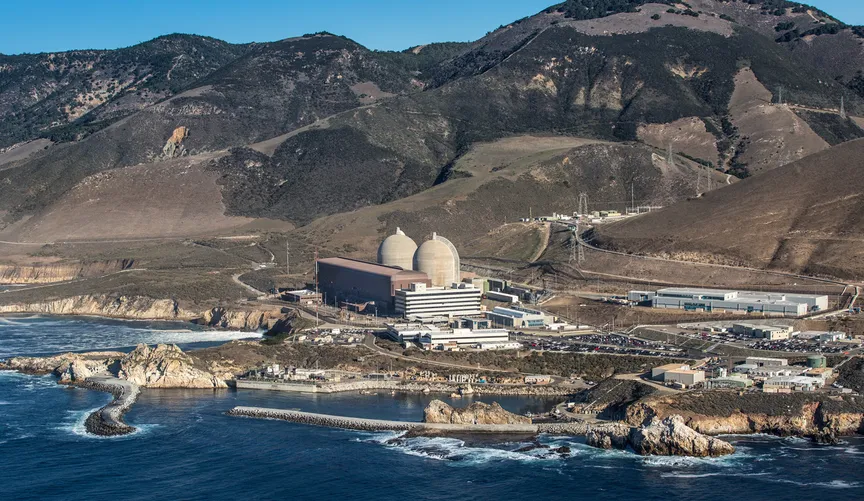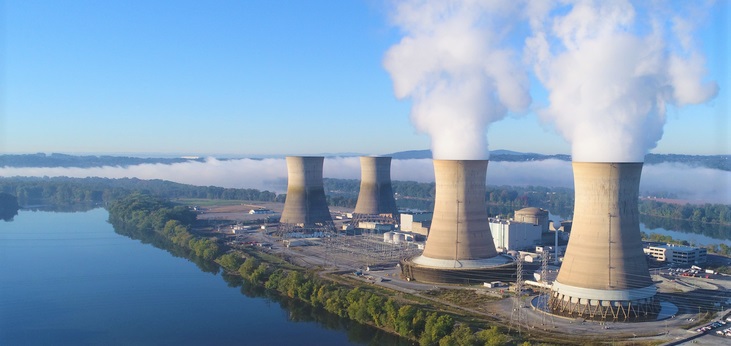By now, pretty much everyone knows that President Biden signed the Inflation Reduction Act into law last month.
Whether it’ll reduce any inflation remains to be seen.
But something that can be seen is all the funding packed into it for alternative energy investments.
And I say “alternative energy” and not “renewable energy” or “green energy” because I’m playing semantics.
You see, there’s a lot of funding for things like wind power and solar energy projects.
And there are penalties for using “dirty” energy like coal and oil.
But there are also tens of billions of dollars up for grabs in an industry that doesn’t usually get much love from the environmental posse.
And that’s nuclear power…
$40 BILLION and Counting
You see, Congress has made a lot of promises about reducing our reliance on fossil fuels and cutting carbon emissions.
But unfortunately, after 30 years and trillions of dollars in investments, hydrocarbons still make up about 82% of our energy mix.
That’s down from 84% when I was still a kid.
Renewable energy — the kind we’ve become accustomed to, at least — just can’t cut it on a large scale.
Wind turbines and solar panels are fine for powering a single home or maybe even a small town or sparsely populated state.
But when it comes to grid-level power, they just can’t shoulder the burden. And while you’ll never hear them admit it on record, our politicians know this.
Even the ones who’ve been the loudest proponents of cutting carbon and ending oil…
So they snuck a whole lot of funding into this Inflation Reduction Act that will help them achieve their goals without sending the whole country into a rolling blackout.
And they included $40 BILLION of funding to the Department of Energy’s loan program to help foster a more robust American nuclear power industry.
But that’s just the start. There’s also $280 million in funding for the DOE’s Office of Science to “carry out activities for fusion energy science construction and major items of equipment projects.”
That’s government-talk for “building advanced nuclear reactors.”
And it isn’t just the federal government getting in on the action, either…
Environmentalists in California Go Nuclear
Just last week, Gov. Gavin Newsom made a shocking announcement to those of us who’ve followed his career…
He signed an extension on the life of California’s last remaining nuclear power plant, Diablo Canyon.

Diablo had been scheduled to shut down this year.
But in the face of a mounting global energy crisis that’s hit Californians even harder than most Americans, Newsom made the call to keep it running for at least five more years.
It’s shocking if you know him because for his entire career as a career politician, Newsom has been one of the BIGGEST opponents of the Diablo Canyon nuclear plant.
He’s been calling for its destruction since before he was governor and long before the state was suffering from the highest energy prices in its history.
But now he’s turned a full 180 degrees and is calling for an extension of its life. And he’s not the only environmentalist who’s gone nuclear.
In fact, the most vehement arguments for saving Diablo Canyon came from pioneering climate scientist James Hansen of Columbia University and Stewart Brand, founder of the environmental publication Whole Earth Catalog.
Even the environmentalists, the biggest and crunchiest of them, are calling for more nuclear power.
But they’re not looking for a return to the days of Three Mile Island and those massive cooling towers and potentially equally massive radiation leaks.
They’re all talking about a different kind of nuclear power. And it goes back to that fancy “government-talk” I explained a little earlier…
Join Wealth Daily today for FREE. We’ll keep you on top of all the hottest investment ideas before they hit Wall Street. Become a member today, and get our latest free report: “How to Make Your Fortune in Stocks”The Best Free Investment You’ll Ever Make
It contains full details on why dividends are an amazing tool for growing your wealth.
It's Fusion, not Fission
The kind of nuclear power we all usually think of is the Three Mile Island kind, or the Simpsons kind.
You know, those parabolic-shaped towers with a steady stream of white steam coming out of them…

That’s a picture of the Calvert Cliffs nuclear plant a little way down the Chesapeake Bay from me.
But that’s not what I’m talking about and that’s not what the new proponents of nuclear are talking about either.
They’re talking about entirely different types of nuclear energy created by entirely different types of reactions in entirely different types of reactors…
What you and I are familiar with, and what’s happening at Calvert Cliffs and Diablo Canyon, is called fission.
That’s when we separate (or split) two heavy, unstable atomic nuclei into two lighter nuclei, releasing energy.
It’s the basis of most nuclear energy in the world and also the nuclear bombs the U.S. dropped on Japan.
But it’s a very rudimentary form of nuclear energy and it’s also not very powerful.
You see, we can take the waste from fission — the two lighter nuclei that are created from splitting the heavier unstable ones — and crash them back together.
And the combination of those two light atomic nuclei releases even more energy than the fission reaction that created them.
That’s called a fusion reaction. And it's the future of nuclear power.
It’s safer. It generates less waste. And it requires far less space to produce the same amount of energy.
Plus, it can create what’s known as grid-level power, or power that can sustain the demands of an entire national energy grid 24 hours a day, seven days a week.
But there’s one major catch…
That’s the fact that most of that kind of nuclear technology is still experimental…
But there's a step between the two kinds of nuclear power that uses a silghtly different fuel in a slightly different kind of reactor powering a slightly different kind of fission reaction.
It's also safer and requires less fuel. And the reactors needed are far smaller – like the fusion ones we discussed earlier.
But again, there's a catch…
And that catch is that the the companies that have developed working small-scale fission reactors are all privately held, like Bill Gates’ company TerraPower.
But it’s those companies and their suppliers that are going to get the lion’s share of the funding President Biden just signed into law since their reactors are ready and the fusion ones are still entirely experimental.
So, being an investor, I decided to do some digging and see who TerraPower was relying on to develop and power its new nuclear reactors.
One Ring Company to Rule Supply Them All
And I found out that it’s partnered with a public firm to provide it with the fuel it needs to run those new, small fusion reactors.
But it didn’t just partner with this firm because it makes the best fuel or because it offered the best price.
Bill Gates and his company partnered with this firm because it is the ONLY company in the entire country with a license to produce the kind of fuel these advanced reactors use.
Gates didn’t partner with this firm because he wanted to. He partnered with it because he had to.
It literally has him in a tight grip by the shortest and curliest hairs he has on his body.
Without the fuel it — and only it — can produce, his reactors and the company that makes them are 100% WORTHLESS!
But the thing is, he’s not the only one who’s caught between a rock and a hard place when it comes to supplying the fuel the next generation of nuclear reactors will need.
Every company in the entire country that hopes to get a piece of the tens of billions of dollars Biden just unleashed needs the fuel that this company makes.
And there is no alternative. It’s the only company in the United States with a license to produce this kind of nuclear fuel.
So unless Bill Gates and the other nuclear entrepreneurs want to buy their fuel from China or want to try to get around sanctions to buy it from Russia, they’ve got no other choice.
They MUST partner with this firm. Period. Hard stop.
And that means this firm is going to see a whole lot of the funding the president and Congress just unleashed on the nuclear industry.
It might not get it directly from the government, but it’s going to get it secondhand from every single company trying to develop the nuclear reactors that will power the next American century.
And investors who get in early on Bill Gates’ only lifeline are likely to pocket a pretty big chunk of that nuclear money, too.
So, because I want you to be one of those investors, I’ve put together a full presentation detailing the entire opportunity.
All you have to do is watch, hear what I’ve uncovered, and get yourself invested.
Just don’t wait too long. This company’s stock shot up 50% last month and it’s still on the move.
Another couple of weeks and we might all be millionaires. So check it out today and don’t miss any more gains.
To your wealth, Jason Williams After graduating Cum Laude in finance
and economics, Jason designed and analyzed complex projects for the U.S. Army. He made the jump to the private
sector as an investment banking analyst at Morgan Stanley, where he eventually led his own team
responsible for billions of dollars in daily trading. Jason left Wall Street to found his own
investment office and now shares the strategies he used and the network he built with you. Jason
is the founder of Main Street
Ventures, a pre-IPO investment newsletter; the founder of
Future Giants, a nano cap investing service; and authors The Wealth Advisory income stock
newsletter. He is also the managing editor of Wealth
Daily. To learn more about Jason, click here. Want to hear more from Jason? Sign up to receive emails directly from him ranging from market commentaries to opportunities that he has his eye on. 
Correction Notice: Original article updated to correct description of TerraPower reactors from fusion to fission. H/T to Ron Adams for noting the error.

 @TheReal_JayDubs
@TheReal_JayDubs Angel Research on Youtube
Angel Research on Youtube


